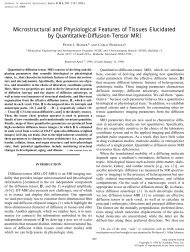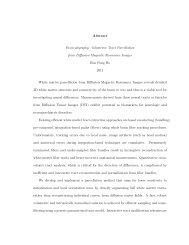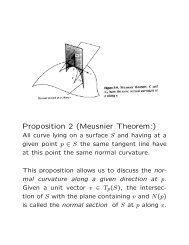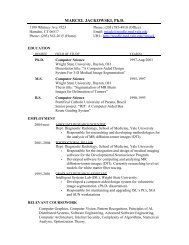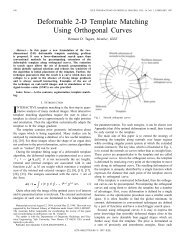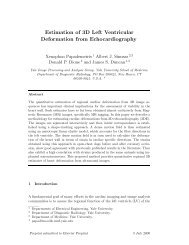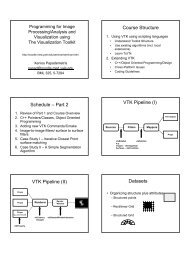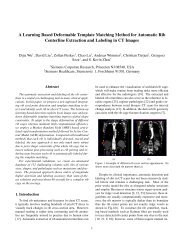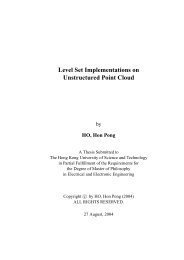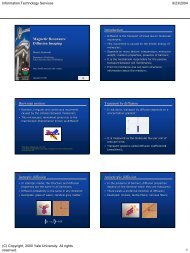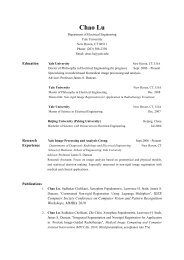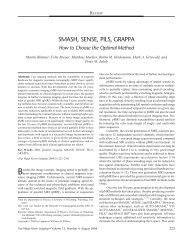Pulsed-field gradient nuclear magnetic resonance as a tool for ...
Pulsed-field gradient nuclear magnetic resonance as a tool for ...
Pulsed-field gradient nuclear magnetic resonance as a tool for ...
You also want an ePaper? Increase the reach of your titles
YUMPU automatically turns print PDFs into web optimized ePapers that Google loves.
222<br />
PRICE<br />
Figure 17 Sequences <strong>for</strong> removal of background <strong>gradient</strong>s.<br />
Ž A. The Karlicek and Lowe sequence Ž 91 . , Ž B.<br />
the nine pulse sequence of Cotts et al. Ž 92 . , Ž C. the<br />
improved stimulated echo sequence of Latour et al.<br />
Ž 77 . , and Ž D. the PFG multiple-spin-echo Ž PFG MSE.<br />
pulse sequence of Van Dusschoten et al. Ž 86 . .<br />
the T2 relaxation time of the macromolecule is<br />
much less than that of the water so that by the<br />
end of the 1 period the macromolecules are fully<br />
relaxed, where<strong>as</strong> the relaxation of the water magnetization<br />
is insignificant. After the application of<br />
the second 2 pulse, the z magnetization of the<br />
macromolecule will be zero, since it w<strong>as</strong> entirely<br />
aligned along the z axis prior to the pulse. For<br />
the water magnetization, the situation is entirely<br />
different; after the pulse, the water magnetization<br />
Ž . Ž . 1<br />
is proportional to cos qz , where q 2 g<br />
recall that the <strong>gradient</strong> pulse creates a helix<br />
along the direction of the <strong>gradient</strong> with a period<br />
of 2Ž g ..<br />
However, <strong>as</strong> qz ranges over many<br />
periods, the net z magnetization over the sample<br />
is zero. Thus, the local normalized deviation from<br />
equilibrium in the macromolecule ph<strong>as</strong>e will be<br />
1, and <strong>for</strong> the water ph<strong>as</strong>e, cosŽ qz. 1. Thus,<br />
during 2,<br />
cross-relaxation results from the equilibrium<br />
differences in both ph<strong>as</strong>es. Consequently<br />
the cross-relaxation rate will depend on q. Equations<br />
have been derived to account <strong>for</strong> this crossrelaxation<br />
in a two-ph<strong>as</strong>e system Ž 93 . . If significant<br />
cross-relaxation occurs, it can affect the<br />
me<strong>as</strong>ured signal intensities, thereby complicating<br />
diffusion me<strong>as</strong>urements. Under limited conditions,<br />
it is possible to determine the exchange<br />
parameters to allow D to be calculated correctly.<br />
Importantly, the problem of cross-relaxation does<br />
not apply to the Stejskal and Tanner sequence.<br />
Multiple Quantum and Hetero<strong>nuclear</strong><br />
Experiments<br />
It is often desirable to work with heteronuclei,<br />
especially when me<strong>as</strong>uring the diffusion coefficient<br />
of nuclei in a complex mixture such <strong>as</strong> a<br />
biological fluid. However, heteronuclei generally<br />
have a sensitivity far beneath that of protons.<br />
Further, because of the low gyro<strong>magnetic</strong> ratios<br />
of heteronuclei, larger <strong>gradient</strong>s must be used.<br />
The most straight<strong>for</strong>ward means of alleviating the<br />
signal-to-noise problem is through the use of<br />
specifically labeledenriched probe molecules.<br />
Large gains in sensitivity can be made through<br />
using pulse sequences to generate polarization<br />
transfer from protons to the heteronuclei Ž94,<br />
95 . . This approach h<strong>as</strong> the advantage of generating<br />
multiple quantum transitions. Multiple quantum<br />
transitions can, of course, also be used in<br />
homo<strong>nuclear</strong> work Ž 96, 97 . . Multiple quantum<br />
spectra are also generally simpler and better resolved<br />
than the corresponding single quantum<br />
spectra; and <strong>for</strong> n coupled protons, the n-quantum<br />
transition is free of dipolar couplings. This<br />
may also allow an incre<strong>as</strong>e in the possible observation<br />
time owing to decre<strong>as</strong>ed relaxation Ž 98 . .<br />
Furthermore, in the c<strong>as</strong>e of homo<strong>nuclear</strong> studies,<br />
multiple quantum spectra have the added benefit<br />
of providing solvent suppression. However, there<br />
are some restrictions on the applicability of multiple<br />
quantum PFG experiments, since the spec-<br />
trum of the species in question must have either a<br />
Ž<br />
scalar, dipolar, or quadrupolar coupling e.g., Refs.



